
|

|
Viking Age Arms and Armor
Viking Bow and Arrow
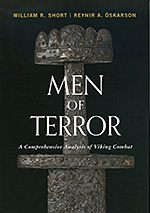 |
Much of the text presented on this page is out-of-date. Until we find time to make the needed updates to this page, we strongly encourage readers to look at this topic as it is presented in our new book, Men of Terror, available now from your favorite book seller. |
Bows were used primarily for hunting, but they were also used in battle in situations where men desired to target their opponents from a long distance away. In mass battles, archers opened the action before the opposing sides closed to fight at close range.
Perhaps the most notable use of a bow in the sagas is Gunnar's single-handed defense at his home, Hlíđarendi (right), against an attack led by Gizurr hvíti, told in chapter 77 of Brennu-Njáls saga. From a loft in the upper level of the house, Gunnar used his bow to kill or wound ten of his opponents before his bow string was cut by one of the attackers. |
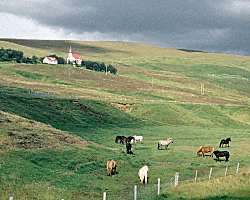 |
In the battle on the ice at Vigrafjörđur described in chapter 45 of Eyrbyggja saga, the sons of Ţorbrandr took a defensive position on a rock above the ice, where they had good footing. Steinţór and his men had a hard time on the ice against such a strong defense. Two Norwegians with Steinţór ran a short distance across the ice to where they could fire arrows at those on the rocks, making things very dangerous for Ţorbrand's sons.
 |
The fjord is shown as it looks today in the photograph to the left. The saga says that Snorri gođi's shepherd watched the battle from the rock cliff at the extreme left edge of the photo, then ran back to Helgafell to get help. |
Bows were used in nautical battles. Once engaged, men on opposing ships fired arrows and threw missiles from one ship to the other, attempting to clear the decks of men so that the ship could be taken. Chapters 106-111 of Ólafs saga Tryggvasonar describes the sea battle at Svölđr in the year 1000, in which King Ólafr was killed.
|
King Ólafr was on board his ship, Örmurinn langi (The Long Serpent), shown to the right in a 19th century painting by Sinding. The saga says the king shot most often with his bow, but sometimes threw spears. With him was Einar, described as the best shot anywhere. Einar fired two close shots at Earl Eiríkr, before Eiríks bowman, Finn, fired an arrow that hit Einar's bow. With the next shot, Einar's bow broke. King Olaf asked, "What cracked with such a loud noise?" Einar replied, "Norway out of your hands, sire." |
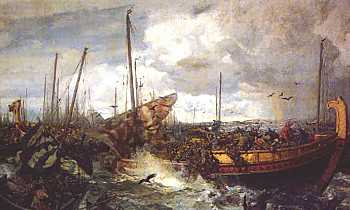 |
As with other weapons, bows were used to threaten. Before the battle at Svölđr, Úlfr, one of King Ólaf's men on board Örmurinn langi, questioned the king's command, implying cowardice on the part of the king. Ólafr fitted an arrow to the bow in his hand and aimed it at Úlfr, who said, "Shoot in another direction, king, where the need is greater."
 |
A reproduction bow is shown to the left. Bows were made from the wood of a yew, ash, or elm. Typically, they were 1.6 to 2m (60 to 80 in) long. A complete bow found at Hedeby was made of yew and was 192cm long. |
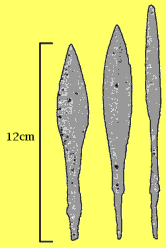 |
Arrow heads were made in a variety of shapes and sizes. Some historic arrowheads from the 10th century found in Norway are shown in the sketch to the left. The shortest is 12cm (5in) long. Arrowheads are not commonly found in the graves of warriors, suggesting that bows were not thought of as tools for warriors. Most arrowheads are found at house sites, which might suggest that bows were thought of domestic tools, used for hunting. Perhaps a good analogy is that the Viking-age bow was used in the same way as a shotgun on a modern farm, rather than as a military rifle on the modern battlefield. The forked arrowhead shown to the right was found at a house site in Reykjavík in Iceland. Arrowheads in good condition were found at several Icelandic house sites dating from the Viking age, and they range in length from 10-15cm (4-6in). Arrowheads had a tang which was driven into a hole in the shaft and secured with cordage and pitch. The tang is clearly visible in the photo to the right. Although evidence is very slight, shafts were probably 70 to 80cm (28-32in) long, and perhaps 10mm (3/8in) in diameter. Shafts were probably made out of hardwood, in order to hold the tang. |
 |
The estimated draw weight of one 10th century bow is 90lbs (40kgf), and the effective range of this weapon was about 200m (650ft).
However, medieval Icelandic law gives a different estimate. The distance of the flight of an arrow, ördrag (bowshot) was a unit of measure commonly used in Icelandic law. For example, Grágás, the medieval Icelandic law book, requires that the court empowered to confiscate an outlaw's property be held within a bowshot of the outlaw's home (K 62). A later addition to Grágás defines the bowshot to be two hundred fađmar (about 480m).
It seems likely that archers used bows with draw weights to fit their capabilities, so there must have been some variation in the draw weights of bows. After Einar's bow was broken at the battle at Svölđr, the king threw him his own bow, telling Einar to continue to shoot. Einar fitted an arrow, and unaccustomed to the king's light bow, drew the head behind the bow. "Too weak, too weak is the king's bow." He threw the bow aside and took up his sword and shield. |
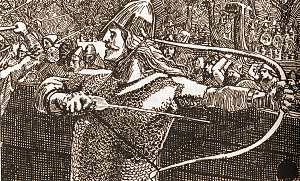 |
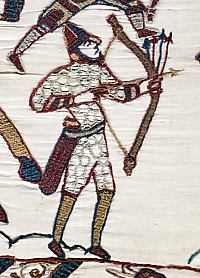 |
It's not clear how arrows were carried. There does not seem to be a lot of
evidence for a quiver. The word (örvamćlir) is not used in the Sagas
of Icelanders, although it does appear in the legendary saga (such as Örvar-Odds saga).
Oddur carried his quiver and arrows on his back. Fragments of leather
interpreted as parts of a quiver have been found in the trading town at
Hedeby.
When Gunnar was ambushed (Brennu-Njáls saga, ch.72), the saga tells us that he pulled out his arrows and threw them on the ground before him and started shooting, wounding many men and killing some. The passage suggests he carried them in some readily accessible holder, such as a quiver. The Bayeux tapestry (right) shows an archer in battle, quiver at his waist, holding his arrows in his hand in preparation for some quick shooting (left). |
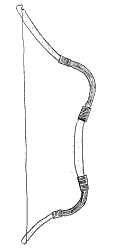 |
Available evidence suggests that only longbows were used in Viking lands. However, some intriguing but speculative evidence suggests that composite recurve bows similar to those used in eastern Europe and Asia may have been used in Viking lands. A sketch of an eastern recurve bow is shown to the left, and a photo of a historical Asian reflex bow to the right. Typically, this type of bow was made from multiple materials, such as wood, sinew, and horn or bone. A recurve bow is shaped such that the tips bend away from the archer when unstrung. A reflex bow (right) is even more extreme, in that the bow bends away from the archer when unstrung over its entire length. Both the bows to the right and the left are shown in the same orientation; when strung, the tips of the bow on the right would bend back to the left, as shown in the sketch. Bows made in this manner store more energy for a given bow length. Thus a short recurve bow has a range nearly as great as that of a longbow, offering advantages to archers in situations where the longer bow would be troublesome, such as in dense forests or on horseback. Some historical recurve bows are asymmetric, with the upper limb longer than the lower, as shown in the sketch, making them better suited for use on horseback. The Icelanders referred to these bows as húnbogi (Hunnish bows), although the only reference to them in the Icelandic saga literature appears to be as personal names (such as Húnbogi inn sterki in Laxdćla saga, and Húnbogi Ţorgilsson, the father of a 12th century lawspeaker). The term does not appear in any of the Sagas of Icelanders referring to a bow of any kind. Konungs skuggsjá (The King's Mirror), a 13th century Norwegian training text, refers to a hornbogi (horn bow) as being a useful weapon for a mounted warrior, since it is easy to draw while on horseback (chapter 38). The hornbogi may refer to a recurve húnbogi, made partially of horn. |
 |
| The
trail of evidence that suggests the use of recurve bows begins in
Brennu-Njáls saga, chapter 63.
Gunnar and his brothers
Kolskeggr and Hjörtr were ambushed by Starkađr and a much larger band
of men. The brothers were able to kill fourteen of the ambushers, while on their side,
only Hjörtr was killed. The battle took place on the shore of the
Eystri-Rangá river, near the large stone known as Gunnarssteinn, shown in the
foreground of the photo to the right. In the 19th century, erosion brought to light several graves above the river, a short distance from Gunnarssteinn. In the photograph, the grave sites are on the right in the photo, on the other side of the road across from the stone. |
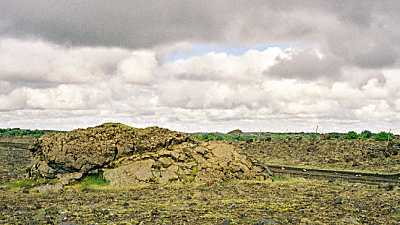 |
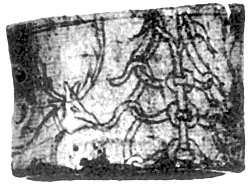 |
One of graves contained a decorated ring made of bone. The ring is fairly large: about 3.8cm (1.5in) in diameter. It seems too big to be a finger ring, but too small to be a bracelet. A photo is shown to the left. |
|
Interestingly, the ring was decorated with images of harts (stags). The name Hjörtr means hart. Did the ring belong to Hjörtr? Is it Hjörtr who was buried in this grave immediately adjacent to the battle site? The evidence is not convincing, but it is an intriguing coincidence. Archaeologists have speculated further on this find, suggesting that the ring is a thumb ring of the type used by eastern European bowmen to protect their thumbs while using a bow. The draw weight of the eastern recurve bows can be substantially over 100 pounds (45kgf). These bows are drawn with string hooked in the thumb, the strongest digit. The string rests on the ring, which protects the thumb. The use of these kind of rings is well documented in eastern Europe and Asian lands. |
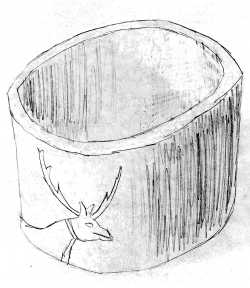 |
Combining all these speculative elements together, it has been suggested that the thumb ring indicates that Hjörtr used an eastern style recurve bow, making it likely that his brother Gunnar, Iceland's most celebrated bowman, may have used one as well. If so, then recurve bows may have been known and used in Norse lands in the Viking era
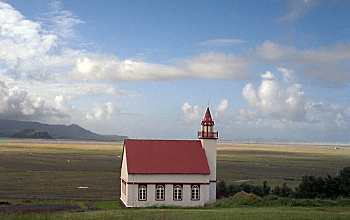 |
It's certainly plausible that Icelanders and other Norse people came in contact with this kind of bow on trading voyages to eastern Europe and Asia, or in service with the Varangians in Constantinople during the Viking age. Portions of a composite bow have been found at the Viking trading town of Birka in Sweden. Some evidence contradicts this conclusion. The saga says that Hjörtr was carried home by Gunnar on his shield and buried there, rather than at the battle site. If home means Gunnar's home at Hlíđarendi (left), it is a considerable distance from the battle site where the ring and skeletal remains were found. Additionally, surviving eastern thumb rings have a different shape than the bone ring found at Gunnarssteinn, with characteristic features missing from this ring, although at least one modern archer has expressed the opinion that the artifact would serve as an archer's thumb ring. |
I find the evidence too scanty to support the conclusion that eastern recurve bows were used by Vikings, but perhaps more supporting evidence will come to light in the future.
|
|
<< Previous article |
Back to Arms and Armor |
Next article >> |
|
©1999-2025 William R. Short |